XXXXXXXXXXXXXXXXXXXXXXXXXXXXXXXXXXXXXXXXXXXXXXXXXXXXXXXXXXXXXXXXXXXXXXXXXXXXXXXXXXXXXXXXXXXXXXXXXXXXXXXXXXXXXXXXXXXXXXXXXXXXXXXXXXXXXXXXXXXXXXXXXXXXXXXX''"> 4.1 Accessing Results
This form appears when the Analysis toggle is selected on the main menu and the Action is set to Access Results. The Object you select defines the type of results file to be read or accessed from the analysis. The following file types are available: XDB, Output2, MASTER, T16/T19 and 3dplot (for SOL 700). The Method choices are:
Result Entities,
Model Data, or
Both.
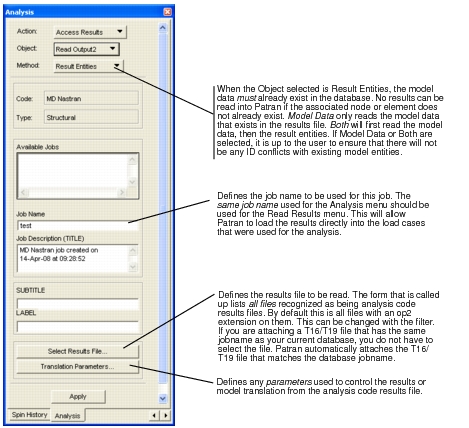
Results File Formats
Output2 Formats
The Patran MD Nastran interface supports several different OUTPUT2 file formats. The interface, running on any platform can read a binary format OUTPUT2 file produced by MSC.Nastran running on any of these same platforms. For example, a binary OUTPUT2 file produced by MD Nastran running on an IBM RS/6000 can be read by Patran running on DEC Alpha. Patran may be able to read binary format OUTPUT2 files from other platforms if they contain 32 bit, IEEE format entities (either Big or Little Indian).
For platforms that do not produce OUTPUT2 files in these formats, Patran MD Nastran can read OUTPUT2 files created with the FORM=FORMATTED option in MD Nastran. This option can be selected from the Analysis/Translation Parameters form in Patran and directs MD Nastran to produce an ASCII format OUTPUT2 file that can be moved between any platforms. The Patran MD Nastran interface detects this format when the OUTPUT2 file is opened, automatically converts it to the binary format, and then reads the model and/or results into the Patran database.
An OUTPUT2 file is created by MD Nastran by placing a PARAM,POST,-1 in the bulk data portion of the input file. The formatted or unformatted OUTPUT2 file is specified in the FMS section using an ASSIGN OUTPUT2 = filename, UNIT=#, FORM=FORMATTED (or UNFORMATTED). See
Translation Parameters, 255.
XDB Formats
The same basic issues exist for MSC.Access databases as for OUTPUT2 files. For example, the MSC.Access database (xdb file) may be exchanged between computer Systems that have binary compatibility. That is, an XDB file generated on a SUN Machine may be used on an IBM/AIX, HPUX or SGI computers.
However, in order to exchange the XDB file on binary incompatible machines, one needs to use the TRANS and RECEIVE utilities delivered with every installation of MD Nastran.
TRANS converts an XDB file generated by MD Nastran to an “equivalent” character, i.e. ASCII, file which can be transported to another computer across the network via ftp or rcp. RECEIVE converts the character file back into the XDB format for postprocessing.
For more information on TRANS and RECEIVE utilities, please consult the “Configuration and Operations Guide” for V70 of MSC.Nastran.
A MSC.Access XDB database is created by MD Nastran by placing a PARAM,POST,0 in the bulk data portion of the input file. See
Translation Parameters, 255.
In this release of the product, it is assumed that the Geometry, loads and results output all reside in the same physical XDB file. That is, "split" XDB databases are not supported.
MASTER Formats
Using the MASTER format, you can attach to the MD Nastran database directly saving the extra step of creating alternate form of MD Nastran model and results data, i.e. OP2 and/or XDB. Because the model and results data in the MD Nastran database tends be sequential in nature, an index provides fast “direct” access to the data. The indexing is accomplished by two indexing modules in MD Nastran named: ifpindx and ofpindx.
The DRA/DBALL capability uses the MD Nastran toolkit, i.e. MNT, capability. The MNT interfaces with the MD Nastran executable in a client-server. This means that in order to use the DRA/DBALL feature one needs to have access to MD Nastran installation. If you do not have access to a MD Nastran installation you will need to use the MD Nastran mini server that is delivered with Patran to import DRA/DBALL files.
To point to a MD Nastran installation, the location of the MD Nastran executable is set in the following files: p3_trans.ini(NT), .site_setup(UNIX,LINUX). On Windows NT, the “ACommand20xx” must be set to the MD Nastran executable. On UNIX, on the other hand, “MSP_NASTRAN_CMD20xx” needs to be set to the MD Nastran executable.
To point to a MD Nastran mini server, the location of the MD Nastran mini server executable must be set on Windows with the “AcommandNasServer” environment variable. On UNIX, you must set the environment variable “MSCP_NASTRAN_SERVER” . By default the MD Nastran mini server is located in $P3_Home/mscnastran_files/servermode/nastran.exe.
Note that you are required to point to a V2004 or later version of MD Nastran. If you specify an MSC.Nastran executable earlier than V2004 you will be presented with a modal form preventing you from using this capability. However, you may bypass this restriction by setting the “DRA_NAST_NOVEDRCHK” environment variable.
The DRA/MASTER functionality only supports static analysis (SOL101). This includes the support of Superelements, grid point forces and other result types available in the OP2 or XDB translators.
This capability supports importing the model data into Patran database. Moreover, since this capability reuses the import/bdf functionality all of the model information available in the database shall be imported including Nodes, Elements, Coordinate systems, material properties, physical properties, loads and boundary conditions, load cases, parameters and etc...
The “indexing” modules are tied to a system cell. That is, an MD Nastran database is indexed and saved by MD Nastran by setting system cell “316” to a value “7”. This system cell tells MD Nastran executable to create index files for IFP and OFP datablocks and move the indexed datablocks to the “MASTER” file. This means that one can even delete the “DBALL” file after the MD Nastran run completes. For example, if you would like to get an Indexed MASTER data file for the job some_job.bdf, the following must be executed:
< ...>/nastran some_job.bdf sys316=7 scr=no sdir=/tmp
This example generates a “some_job.MASTER and some_job.DBALL database files. You can delete the *.DBALL file because it does not contain any results or model data of importance. However, if you would like to perform a restart from the run then the DBALL file must be kept for future use but the “Master” file may be moved to other directories at will.
The MD Nastran toolkit environment is derived from the MD Nastran installation via the use of the “rc” files which is documented in the MSC.Nastran (p. 1) in the MSC.Nastran 2004 Installation and Operations Guide. For example, you can set the amount of memory used by the MD Nastran to 20 mega-words by setting the “memory=20MW” in one of the “rc” files, i.e. nastran.rcf file in the current working directory on the NT platform. This setting can be double checked using the MD Nastran “whence” command as follows:
< ...>/nastran some_job.bdf whence=mem
The same basic issues exist for attaching to an Indexed MD Nastran database as attaching an XDB database. That is, the MD Nastran database (MASTER file) may be exchanged among computer Systems that have binary compatibility. That is, a MASTER file generated on a SUN Machine can not be used on an IBM/AIX, HPUX or SGI computers.
However, at this time it is not possible to exchange the MASTER file on binary incompatible machines.
T16/T19 Formats
The T16 file is the MSC.Marc binary results file and the T19 file is the MSC.Marc ASCII results (POST) file that are created by a SOL 600 analysis, the contents of which can be imported or attached for postprocessing. When domain decomposition is used, multiple files are produced where # is the domain number. This file format is recommended for post-processing SOL 600 runs since it has more information, such as contact info and additional nonlinear analysis information, then the xdbor OP2 formats.
These results file types are used for accessing SOL 600 results.
3dplot Formats
The 3dplot ptf file is the LS-Dyna binary results file that are created by a SOL 700 analysis, the contents of which can be attached for postprocessing.
This option is available only for Explicit Nonlinear.
Translation Parameters
OUTPUT2
This subordinate form appears when the Translation Parameters button is selected and
Read Output2 is the selected Object. When reading results there are three Method options that may be selected
: Result Entities,
Model Data or
Both. This form affects import of all these objects as noted below
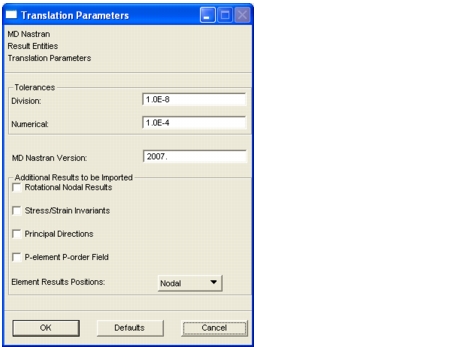
Tolerances | |
• Division | Defines the tolerances used during translation. The division tolerance is used to prevent division by zero errors. The numerical tolerance is used when comparing real values for equality. When the Object is set to Model Data, only these tolerances are available. |
• Numerical |
MSC.Nastran Version | Specifies the version of MSC.Nastran that created the OUTPUT2 file to be read. Solid Element orientation differs between versions less than 67 and version 67 and above. Elementally oriented Solid element results may be translated incorrectly if the wrong version is specified. |
Additional Results to be Imported | |
• Rotational Nodal Results | Indicates which results categories are to be filtered out during translation. Rotational Nodal Results, Stress and Strain Invariants, and Stress and Strain Principal Direction Results can be skipped during translation. Items selected will be translated. Items not selected will be skipped. By default, Rotational Nodal Results, Stress and Strain Invariants, and Stress and Strain Tensor Principal Directions are ignored during translation. |
• Stress/Strain Invariants |
• Principal Directions |
• P-element P-order Field | Creates a field that describes the polynomial orders in all p-elements in the model at the end of an adaptive cycle. |
Element Results Positions | If an element has results at both the centroid and at the nodes, this filter will indicate which results are to be included in the translation. |
Defining Translation Parameters for DDAM (SOL 187)
Patran calculates combined stresses (like bar stresses, principal stresses and von Mises stresses by default, rather than reading these values from the OP2 files. If Patran does this, the combined stresses will be incorrectly calculated from summed results. It is necessary to calculate the combined stresses on a mode-by-mode basis, and NRL sum the combined results.
To obtain correct results, it is necessary to explicitly tell Patran to read the combined values. Select the Translation Parameters button on the Analysis form when reading results in. On the form, you can select the box labeled Stress/Strain Invariants. This produces a number of additional results for each result case. These additional results are the correct von Mises and Principal stresses. The ones that Patran displays when you choose Stress Tensor are the incorrect values.
XDB
This subordinate form appears when the Translation Parameters button is selected and
Result Entities is the selected Object.
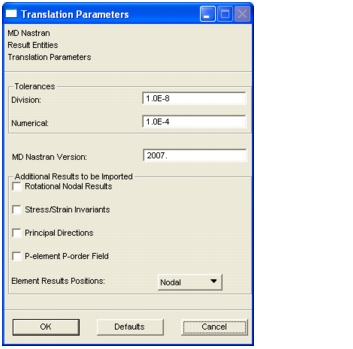
Tolerances | |
• Division | Defines the tolerances used during translation. The division tolerance is used to prevent division by zero errors. The numerical tolerance is used when comparing real values for equality. When the Object is set to Model Data, only these tolerances are available. |
• Numerical |
MSC.Nastran Version | Specifies the version of MSC.Nastran that created the OUTPUT2 file to be read. Solid Element orientation differs between versions less than 67 and version 67 and above. Elementally oriented Solid element results may be translated incorrectly if the wrong version is specified. |
Additional Results to be Imported | |
• Rotational Nodal Results | Indicates which results categories are to be filtered out during translation. Rotational Nodal Results, Stress and Strain Invariants, and Stress and Strain Principal Direction Results can be skipped during translation. Items selected will be translated. Items not selected will be skipped. By default, Rotational Nodal Results, Stress and Strain Invariants, and Stress and Strain Tensor Principal Directions are ignored during translation. |
• Stress/Strain Invariants |
• Principal Directions |
Element Results Positions | If an element has results at both the centroid and at the nodes, this filter will indicate which results are to be included in the translation. |
MASTER
This subordinate form appears when the Translation Parameters... button is selected and
MASTER
is the selected Object.
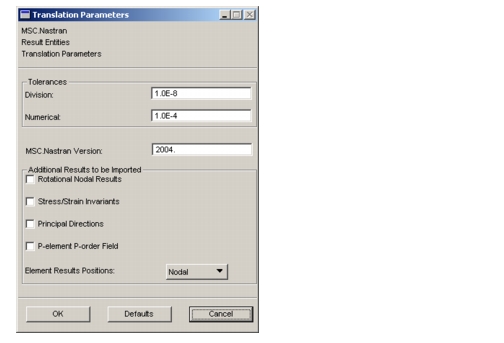
Tolerances | |
• Division | Defines the tolerances used during translation. The division tolerance is used to prevent division by zero errors. The numerical tolerance is used when comparing real values for equality. When the Object is set to Model Data, only these tolerances are available. |
• Numerical |
MSC.Nastran Version | Specifies the version of MSC.Nastran that created the OUTPUT2 file to be read. Solid Element orientation differs between versions less than 67 and version 67 and above. Elementally oriented Solid element results may be translated incorrectly if the wrong version is specified. |
Additional Results to be Imported | |
• Rotational Nodal Results | Indicates which results categories are to be filtered out during translation. Rotational Nodal Results, Stress and Strain Invariants, and Stress and Strain Principal Direction Results can be skipped during translation. Items selected will be translated. Items not selected will be skipped. By default, Rotational Nodal Results, Stress and Strain Invariants, and Stress and Strain Tensor Principal Directions are ignored during translation. |
• Stress/Strain Invariants |
• Principal Directions |
• P-element P-order Field | Creates a field that describes the polynomial orders in all p-elements in the model at the end of an adaptive cycle. |
Element Results Positions | If an element has results at both the centroid and at the nodes, this filter will indicate which results are to be included in the translation. |
T16/T19
This subordinate form appears when the Translation Parameters... button is selected and
T16/T19 is the selected Object.
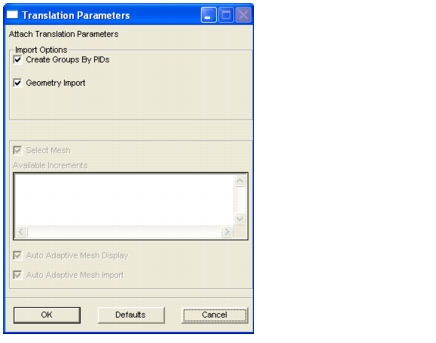
Model Import Options | |
• Create Groups by PIDs | Creates groups for each element type encountered in the model. |
• Geometry Import | Imports any NURB based rigid geometry found in the POST file into the database. |
Select Mesh | Pertains to importing results and model data from adaptive meshing analyses. In order for this toggle to be active, a results file must have been selected first in which case it is scanned to show the available meshes and to which load increments they are associated. You can select which meshes/increments are imported in the provided list box. Adaptive meshing is not supported in MSC.Nastran 2004. |
Available Increments | Defines the increments available for import from the results file. |





